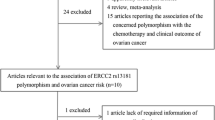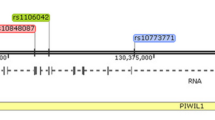Abstract
TP53 is known as a tumor suppressor gene involved in cell cycle regulation. Many previous epidemiological and clinical studies have evaluated the effects of rs1042522 polymorphism on risk of ovarian cancer. But the results are conflicting and heterogeneous. The primary objective of this study was to examine whether rs1042522 polymorphism is associated with ovarian cancer risk. We performed a comprehensive meta-analysis of 19 case–control studies that analyzed rs1042522 polymorphism in ovarian cancer risk. Odds ratios (ORs) were calculated using distinct genetic models. Heterogeneity between studies was detected by the χ2-based Q test. Additional analyses such as sensitivity analyses and publication bias were also performed. The rs1042522 polymorphism was not overall associated with ovarian cancer risk. But there was a borderline association in the heterozygote model (OR = 1.09, 95 % CI 0.99–1.21). Similar effects were observed in the subgroup of Caucasian population (the heterozygote model: OR = 1.11, 95 % CI 1.00–1.24). No significant heterogeneity and publication bias were revealed in this meta-analysis. This study provides statistical evidence that TP53 rs1042522 polymorphism may play a role in modulating risk of ovarian cancer. This observation requires further analysis of a larger study size.



Similar content being viewed by others
References
Weston, A., & Godbold, J. H. (1997). Polymorphisms of H-ras-1 and p53 in breast cancer and lung cancer: A meta-analysis. Environmental Health Perspectives, 105(Suppl 4), 919–926.
Havrilesky, L., et al. (2003). Prognostic significance of p53 mutation and p53 overexpression in advanced epithelial ovarian cancer: A Gynecologic Oncology Group Study. Journal of Clinical Oncology, 21(20), 3814–3825.
Kmet, L. M., Cook, L. S., & Magliocco, A. M. (2003). A review of p53 expression and mutation in human benign, low malignant potential, and invasive epithelial ovarian tumors. Cancer, 97(2), 389–404.
Bar, J. K., et al. (2009). Expression of p53 protein phosphorylated at serine 20 and serine 392 in malignant and benign ovarian neoplasms: Correlation with clinicopathological parameters of tumors. International Journal of Gynecological Cancer, 19(8), 1322–1328.
Matlashewski, G. J., et al. (1987). Primary structure polymorphism at amino acid residue 72 of human p53. Molecular and Cellular Biology, 7(2), 961–963.
Beenken, S. W., et al. (1991). An intron binding protein is required for transformation ability of p53. Nucleic Acids Research, 19(17), 4747–4752.
Walker, K. K., & Levine, A. J. (1996). Identification of a novel p53 functional domain that is necessary for efficient growth suppression. Proceedings of the National Academy of Sciences of the United States of America, 93(26), 15335–15340.
Thomas, M., et al. (1999). Two polymorphic variants of wild-type p53 differ biochemically and biologically. Molecular and Cellular Biology, 19(2), 1092–1100.
Shen, H., et al. (2002). P53 codon 72 polymorphism and risk of squamous cell carcinoma of the head and neck: A case-control study. Cancer Letters, 183(2), 123–130.
Granja, F., et al. (2004). Proline homozygosity in codon 72 of p53 is a factor of susceptibility for thyroid cancer. Cancer Letters, 210(2), 151–157.
Koushik, A., Platt, R. W., & Franco, E. L. (2004). p53 codon 72 polymorphism and cervical neoplasia: A meta-analysis review. Cancer Epidemiology Biomarkers & Prevention, 13(1), 11–22.
Francisco, G., et al. (2011). Arg72Pro TP53 polymorphism and cancer susceptibility: A comprehensive meta-analysis of 302 case-control studies. International Journal of Cancer, 129(4), 920–930.
Jemal, A., et al. (2008). Cancer statistics, 2008. CA: A Cancer Journal for Clinicians, 58(2), 71–96.
Li, T., et al. (2002). p53 codon 72 polymorphism (C/G) and the risk of human papillomavirus-associated carcinomas in China. Cancer, 95(12), 2571–2576.
Kang, S., et al. (2004). Association of p53 gene polymorphism with susceptibility to ovarian cancer. Zhonghua Fu Chan Ke Za Zhi, 39(11), 754–758.
Santos, A. M., et al. (2006). Linking TP53 codon 72 and P21 nt590 genotypes to the development of cervical and ovarian cancer. European Journal of Cancer, 42(7), 958–963.
Mantel, N., & Haenszel, W. (1959). Statistical aspects of the analysis of data from retrospective studies of disease. Journal of the National Cancer Institute, 22(4), 719–748.
DerSimonian, R., & Laird, N. (1986). Meta-analysis in clinical trials. Controlled Clinical Trials, 7(3), 177–188.
Egger, M., et al. (1997). Bias in meta-analysis detected by a simple, graphical test. BMJ, 315(7109), 629–634.
Qie, M., Zhang, Y., & Wu, J. (2002). Study on the relationship between cervical cancer and p53 codon 72 polymorphism. Hua Xi Yi Ke Da Xue Xue Bao, 33(2), 274–275.
Ueda, M., et al. (2006). Germline polymorphism of p53 codon 72 in gynecological cancer. Gynecologic Oncology, 100(1), 173–178.
Pegoraro, R. J., et al. (2003). P53 codon 72 polymorphism and BRCA 1 and 2 mutations in ovarian epithelial malignancies in black South Africans. International Journal of Gynecological Cancer, 13(4), 444–449.
Agorastos, T., et al. (2004). P53 codon 72 polymorphism and correlation with ovarian and endometrial cancer in Greek women. European Journal of Cancer Prevention, 13(4), 277–280.
Morari, E. C., et al. (2006). Role of glutathione-S-transferase and codon 72 of P53 genotypes in epithelial ovarian cancer patients. Journal of Cancer Research and Clinical Oncology, 132(8), 521–528.
Schildkraut, J. M., et al. (2009). Single nucleotide polymorphisms in the TP53 region and susceptibility to invasive epithelial ovarian cancer. Cancer Research, 69(6), 2349–2357.
Buller, R. E., et al. (1997). The influence of the p53 codon 72 polymorphism on ovarian carcinogenesis and prognosis. Cancer Gene Therapy, 4(4), 239–245.
Peller, S., et al. (1999). Polymorphisms of the p53 gene in women with ovarian or endometrial carcinoma. Oncology Reports, 6(1), 193–197.
Hogdall, E. V., et al. (2002). Distribution of p53 codon 72 polymorphisms in ovarian tumour patients and their prognostic significance in ovarian cancer patients. Anticancer Research, 22(3), 1859–1864.
Malisic, E. J., et al. (2013). Association of TP53 codon 72 polymorphism with susceptibility to ovarian carcinomas in Serbian women. European Journal of Obstetrics, Gynecology, and Reproductive Biology, 166(1), 90–93.
Beckman, G., et al. (1994). Is p53 polymorphism maintained by natural selection? Human Heredity, 44(5), 266–270.
Lane, D. P. (1992). Cancer. p53, guardian of the genome. Nature, 358(6381), 15–16.
Levine, A. J. (1997). p53, the cellular gatekeeper for growth and division. Cell, 88(3), 323–331.
Donehower, L. A. (1996). The p53-deficient mouse: a model for basic and applied cancer studies. Seminars in Cancer Biology, 7(5), 269–278.
Hollstein, M., et al. (1994). Database of p53 gene somatic mutations in human tumors and cell lines. Nucleic Acids Research, 22(17), 3551–3555.
Wang, Y., et al. (2004). Effect of the codon 72 polymorphism (c.215G > C, p.Arg72Pro) in combination with somatic sequence variants in the TP53 gene on survival in patients with advanced ovarian carcinoma. Human Mutation, 24(1), 21–34.
Harris, C. C., & Hollstein, M. (1993). Clinical implications of the p53 tumor-suppressor gene. New England Journal of Medicine, 329(18), 1318–1327.
Brekelmans, C. T. (2003). Risk factors and risk reduction of breast and ovarian cancer. Current Opinion in Obstetrics and Gynecology, 15(1), 63–68.
Author information
Authors and Affiliations
Corresponding author
Rights and permissions
About this article
Cite this article
Xi, Y., Liu, C. & Xin, X. Association Between a Single Nucleotide Polymorphism in the TP53 Region and Risk of Ovarian Cancer. Cell Biochem Biophys 70, 1907–1912 (2014). https://doi.org/10.1007/s12013-014-0150-y
Published:
Issue Date:
DOI: https://doi.org/10.1007/s12013-014-0150-y




